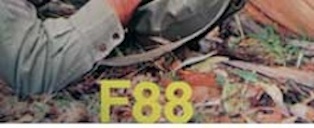
The No4 MkI rifle was adopted Nov 1939 but production of the No4 rifle only starts in earnest in 1941. 2 new factories were set up to produce these rifles, ROF Fazakerley and ROF Maltby. BSA Co. set up the Shirley plant, and additional plants, Longbranch in Canada and Savage in the US were set up to produce rifles. Output of all the plants in 1941 was low perhaps only 25000 rifles. But by the end of WWII over 4 million No4 rifles were produced.

Even though new production methods were used and many of the parts simplified the demand for rifles was higher them production. Various shortcuts were developed and implemented, the original button style cocking piece was replaced with a slab sided cocking piece with vertical grooves. The No4 Mk1* modification saw the simplification of the bolt head release, a slot near the front of the receiver allowed the bolt head to be rotated and removed rather than the plunger and spring behind the charger bridge. A 2 position L shaped rear flip site rather than the milled micrometer adjustable rear site. Many of the other parts were made from stamped metal than machined parts, front site protector, barrel bands, and trigger guard. Some of the other 
 variations were cocking pieces without the half cock notch (deemed unsafe and replaced on most rifles) and cocking pieces without grasping grooves. Barrels started out with 5 grooves left hand twist (Longbranch 5 RH, Savage 6 or 4 LH) and the simplified 2 groove barrel found mostly on Longbranch, Savage and Maltby Mk1*’s. A British manufactured 3 groove barrel that the knox is not forged as part of the barrel but is a heat shrink fitted sleeve on a barrel tube, may be found, however these were also determined to be unsafe and recalled. So we have 2,3,4,5 and 6 grooved barrels some left hand, and some right hand twist. As the war went on and things started looking brighter for the allies some of the expedient parts replaced with better parts as rifles went through field repairs (FR) or factory thorough repair (FTR).
variations were cocking pieces without the half cock notch (deemed unsafe and replaced on most rifles) and cocking pieces without grasping grooves. Barrels started out with 5 grooves left hand twist (Longbranch 5 RH, Savage 6 or 4 LH) and the simplified 2 groove barrel found mostly on Longbranch, Savage and Maltby Mk1*’s. A British manufactured 3 groove barrel that the knox is not forged as part of the barrel but is a heat shrink fitted sleeve on a barrel tube, may be found, however these were also determined to be unsafe and recalled. So we have 2,3,4,5 and 6 grooved barrels some left hand, and some right hand twist. As the war went on and things started looking brighter for the allies some of the expedient parts replaced with better parts as rifles went through field repairs (FR) or factory thorough repair (FTR).

 After WWII further design changes led to the No4 MkII, the trigger mounting was changed to allow the trigger to be hung from the action body rather than from the trigger guard. In addition, light-colored beech wood was officially approved for rifle furniture. It should be noted that the Longbranch and Savage factories made extensive use of Beech and Birch wood throughout the war. It is reported that all but the first few sample rifles produced by Savage were Birch. The British factories also used Beech wood on war time production. The No4 Mk II (or Mk2) was adopted in 1949, with production at ROF-Fazakerley in July, 1949 until 1955. Fazakerley was the only plant to manufacture the No4 Mk2. At the same time that the No4 Mk2 rifle was approved conversion of MkI and MkI* rifles to the Mk2 standard was undertaken. The converted No4 MkI rifle was redesignated the No4 MkI/2 Rifle, while the converted No4 MkI* rifle was redesignated the No4 MkI/3 Rifle, these conversions were also done at ROF-Fazakerley.
After WWII further design changes led to the No4 MkII, the trigger mounting was changed to allow the trigger to be hung from the action body rather than from the trigger guard. In addition, light-colored beech wood was officially approved for rifle furniture. It should be noted that the Longbranch and Savage factories made extensive use of Beech and Birch wood throughout the war. It is reported that all but the first few sample rifles produced by Savage were Birch. The British factories also used Beech wood on war time production. The No4 Mk II (or Mk2) was adopted in 1949, with production at ROF-Fazakerley in July, 1949 until 1955. Fazakerley was the only plant to manufacture the No4 Mk2. At the same time that the No4 Mk2 rifle was approved conversion of MkI and MkI* rifles to the Mk2 standard was undertaken. The converted No4 MkI rifle was redesignated the No4 MkI/2 Rifle, while the converted No4 MkI* rifle was redesignated the No4 MkI/3 Rifle, these conversions were also done at ROF-Fazakerley.







